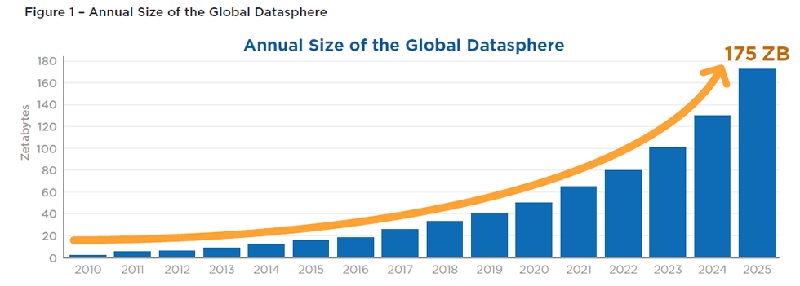‘Datasphere expected to grow manifold by 2025’
Number of zettabytes (ZB) was only 45 ZB in 2019 but is predicted to rise to 175 ZB by 2025
December 23, 2022

The global data storage dilemma is currently affecting the entire world. In 2025, the datasphere is expected to grow by 300%, and "the cloud" won't have enough room to accommodate the "mind-blowing volume."
Scientists at Aston University have issued a warning and are working feverishly to come up with a solution that does not include adding to the 1.5% of servers that consume electricity globally each year.
The team is using new technologies to create surfaces with channels that are fewer than five nanometers wide — roughly 10,000 times smaller than the width of a human hair — in order to address this issue.
The project's director, Dr Matt Derry, said in a statement that "just constructing larger data centres without advancing data storage technology is not a feasible answer."
"Increasingly we face the risk of a so-called data storage crunch and improved data storage solutions are imperative to keep up with the demands of the modern world," DailyMail quoted him as saying.
The global population leads a digital lifestyle that generates vast amounts of data.

The scale of the Global Datasphere will continuously grow as a result of this growing reliance on data, according to a report by the International Data Corporation (IDC).
According to the paper, the number of zettabytes (ZB), a unit of measurement for digital storage capacity, was only 45 ZB in 2019 but is predicted to rise to 175 ZB by 2025.
A trillion gigabytes make up one zettabyte.
"If you were able to store the entire Global Datasphere on DVDs, then you would have a stack of single-layer Blu-ray discs that could get you to the moon 23 times or circle Earth 222 times," IDC shared in the report.
Derry and his team are working to find a solution before the huge spike occurs.
Dr Amit Kumar Sarkar, a recent addition to the Aston University team, said that they would leverage sophisticated polymer chemistry as a means of expanding the quantity of data that can be stored on storage media.
The need for expensive, ecologically harmful building of new "mega data centres" will be greatly reduced by improving the efficiency of existing systems. The following three years will be critical.
Only 2ZB of data was produced and reproduced globally in 2010, according to IDC, but this was just three years after Apple's debut iPhone and just a year after Samsung's entry into the market.
These two devices most likely set off the current rate of data growth.
Data reveals a startling increase between 2019 and 2020, from 41ZB to 64.2ZB, as a result of people working from home during lockdowns that closed offices. By 2025, 80% of all data will be unstructured.
Redgate reports that this is due to the fact that how and where we consume data has changed and will continue to change.
This is divided into three groups by IDC: Endpoints, Edge, and Core.
Smartphones, sensors, and wearable devices are examples of devices at the Endpoints, whereas servers located in offices and data centres make up the Edge. Additionally, the majority of processing and analytics are carried out in enterprise and cloud provider data centres located in the Core.
By 2025, IDC projects that the amount of data generated at the Edge by various IoT and sensing devices will increase by 33% and account for 22% of the entire global datasphere.











